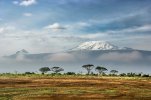- Reviews
- 4
- Joined
- Apr 7, 2011
- Messages
- 1,231
- Reaction score
- 379
- Website
- ss.globalrescue.com
- Deals & offers
- 8
- Media
- 95
- Articles
- 228
- Member of
- Safari Club International, Dallas Safari Club, Grand Slam Club/Ovis
Kilimanjaro (19,341 feet/5,895 meters) may be considered a high-altitude “starter mountain” for climbers, but summiting the “Mountain of Greatness” is no easy task.
It doesn’t require technical climbing skills, ropes, ice axes, harnesses, or other specialized equipment. Depending on the season and the weather, micro-spikes may be needed by individuals reaching the upper slopes if they are snow-covered.
The greatest challenge for most climbers to reach the top of Africa’s highest peak is the altitude.
“While it’s true that Kilimanjaro is accessible to a wide range of people, adequate physical preparation is essential, especially for those without a background in hiking,” said Alex Altezza, CEO of Altezza Travel.
“On Kilimanjaro, climbers typically walk six to eight miles daily, and on the summit night, this can extend to 10 to 15 miles, with much of it uphill. Achieving this feat requires at least an average fitness level,” he said.
Rescue operations on Kilimanjaro by Global Rescue’s expert medical rescue personnel have been taking place for years, and many of the rescue operations are triggered by respiratory problems brought on by the altitude.
In 2011, Global Rescue executed a field rescue for a physician experiencing severe shortness of breath, chest pains and other signs of life-threatening illness as she was climbing the mountain.
About two-thirds of the way to the summit, Michele Donsky complained of tightness in her chest and extreme difficulty breathing. The 55-year-old marathon runner could only speak one or two words at a time before she began wheezing. Her climbing guide, Eddie Frank, owner of Tusker Trail, contacted Global Rescue and an airborne medical evacuation was initiated.
Donsky was transported to a nearby hospital whereupon her condition improved quickly at the lower altitude. She was evaluated by local doctors and maintained regular communication with Global Rescue medical operations staff.
“It was very reassuring to be able to hear the Global Rescue doctor’s voice on the satellite phone and to know that he was making sound decisions for me,” Donsky said. “I had the utmost trust and confidence in him and his team. I would never want to be without this kind of help in this situation, and it would not have been possible had I not signed up with Global Rescue.”
In 2024, A U.S. member needed field rescue after experiencing shortness of breath and vomiting blood while in Karanga Camp, Tanzania, for a Kilimanjaro summit attempt. Global Rescue medical operations spoke with him and the expedition guide and confirmed the member’s cough produced blood-tinged phlegm, and that his breathing difficulty had started earlier in the day.
Due to the severity of his condition, Global Rescue medical operations personnel initiated a helicopter field rescue. The member was successfully evacuated and evaluated at a local hospital in Arusha where he was diagnosed with pneumonia and prescribed antibiotics. He was scheduled to return home to the U.S. to continue his recovery.
Even legendary high-altitude mountaineer, Ed Viesturs, and his Kilimanjaro expedition team opted for Diamox – a common prescription medicine that prevents symptoms of altitude sickness — during his inaugural Kilimanjaro summit in the early spring of 2024.
Viesturs’ team climbed during the rainy off-season and made a rapid, four-day ascent. “Diamox was used prophylactically by the team to help prevent any altitude-related issues. This is not a recommended way to shorten an ascent of a high peak, but we understood the risks. In the end, all went well, and we had no issues,” he said.
Underestimating the altitude impact and the physical challenges of Mount Kilimanjaro is one of the biggest mistakes new climbers make, according to Altezza.
“Many companies market Kilimanjaro as an easy climb, attracting individuals not adequately prepared for the mountain’s demands. This often leads to individuals making impulsive decisions to sign up, without properly preparing themselves physically for the trek.”
Altezza, who has been leading Kilimanjaro expeditions since 2014, said summitting the mountain is a feat that “requires at least an average level of fitness.”
Despite the challenges, participation in mountaineering, trekking, and other high-altitude activities has seen rapid increases in recent years in the Rockies, the Himalayas, the Andes, and Kilimanjaro.
Altezza’s business records reflect the same escalation in the number of climbers on Kilimanjaro. His data also shows a steady uptick in women climbing.
“Among the 2,997 climbers we examined in 2023, 40% (1,204) were women. This distribution indicates that while men continue to represent the majority of climbers, the proportion of female climbers is on a steady rise compared to previous years,” Altezza said.
Whether you’re climbing Mount Kilimanjaro, heli-skiing in the Andes, or trekking the Camino de Santiago, you’ll have access to 24/7/365 medical advisory services, field rescue from the point of injury, and medical evacuation to the nearest hospital or home hospital of choice.
Travel Protection Services Membership



